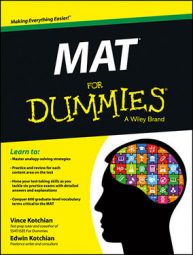The Miller Analogies Test (MAT) is a standardized test normally used for graduate school admissions. The test is composed entirely of analogies. The Miller Analogies Test uses multiple analogy types, such as 1:3,2:4. Recognizing the type of analogy being used plays a crucial role in your ability to select the right answer for that question.
Analogies are simply relationships between words (and sometimes between numbers). Your job for any MAT analogy question is to recognize the relationship presented to you and find its match among the answer choices. Sounds easy, but it might not be.
Sometimes you may not recognize the presented relationship, its match, or even some or all of the terms in the question, making it difficult to select the right answer choice. The first step in dealing with any MAT analogy, however, is identifying its structure so you can choose the right answer to complete the relationship in the analogy.
MAT analogies fit into just two structural types: 1:2,3:4 and 1:3,2:4. In a 1:3,2:4 analogy, the first and third terms in the question have a relationship, and the second and fourth terms in the question have the same relationship.
To help you recognize the structure of a 1,3:2,4 analogy, here is an example.
Ribosome : pancreas :: cell : _________________
(A)body
(B)heart
(C)hormone
(D)molecule
The first term here, ribosome, has a relationship to the third term, cell. A ribosome is a component of a cell. So the second term, pancreas, must have a relationship with the fourth term, which is one of the answer choices. The correct answer is Choice (A), body, because the pancreas is a component of a body.
You can determine that the relationship in this analogy is a 1:3,2:4 because the relationship between ribosome and cell is much stronger than the relationship between ribosome and pancreas. If you wrote a sentence linking ribosome and pancreas, the relationship would probably be pretty weak.
It might seem weird at first, but the MAT can put the answer choices in any position in an analogy (1, 2, 3, or 4). For example, a 1:3,2:4 analogy can be written like this:
Ribosome : pancreas :: _________________ : body
(A)cell
(B)vitamin
(C)liver
(D)atom
It’s still a 1:3,2:4 analogy because the first and third terms and the second and fourth terms have the same kind of clear relationship. The correct answer is Choice (A), cell. Again, a ribosome is a component of a cell, and a pancreas is a component of a body.
Alternatively, the answer choices may come first, as in this question:
_________________ : body :: ribosome : pancreas
(A)cell
(B)vitamin
(C)blood
(D)atom
Guess what? It’s still a 1:3,2:4, since the first and third terms have a clear relationship, as do the second and fourth terms. The right answer is still Choice (A), cell.
As you may guess, the test writers can and will put the answer choices in any of the four positions. But no matter where the choices appear, your first task is to identify whether the question in front of you is a 1:2,3:4 analogy or a 1:3,2:4 analogy. The good news is that it doesn’t really matter where the answer choices show up — the analogy will always be 1:2,3:4 or 1:3,2:4.

